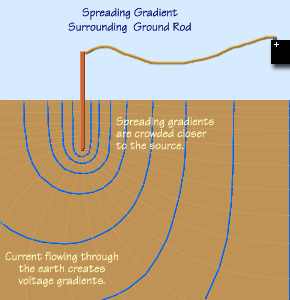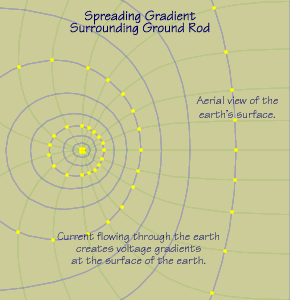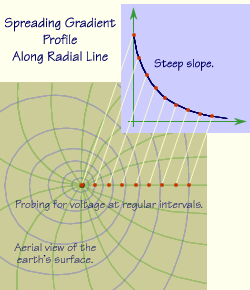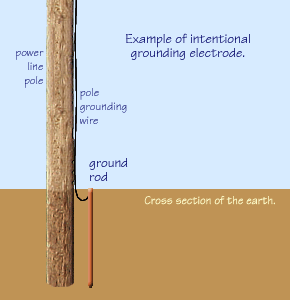Spreading Gradients
in Two-Rod Study Case |
|
|




A spreading gradient is characterized by
ever-decreasing intensity along radial lines,
much like the light from a light bulb decreases with distance from the bulb.
In an electrical system, spreading gradients can be strong, especially near the point
at which the current enters the earth. Indeed, most of the gradient is concentrated in
the current funnel area around the electrodes. This is where most of the electric energy is
dissipated as the current overcomes the spreading resistance entering or leaving the earth. |
 |
 |
|
 
|
 |
 |




At the surface of the earth, spreading gradients take on a symmetrical and concentric
profile. If there is sufficient current, these gradients can result in significant voltage
differences over short distances. These are consequently the gradients of most concern.
As we shall see later, a cow can experience the full range of a spreading gradient
present at a structure that is connected both to the electrical system and the earth,
such as a waterer. |
|
 
|




The illustration shows voltage differences at incremental steps along a radial line. The
resulting profile shows a steep slope that looks like a tall mountain. Spreading
gradients tend to be stronger than field gradients, yielding a larger voltage difference
over a shorter distance.
|
 |
 |
|
 
|
|
Spreading gradients are associated with all electrical system connections to the earth
(including a cow in a stray voltage
situation as it makes contact with the earth).
These connections include such objects as stanchion pipes in barns that are connected to
the electrical system and cemented into the barn floor. Cows that come into contact with
these pipes are exposed to the voltage gradients that exist between the pipe and the
location on the floor where the cow is standing. These connections to the earth are
called electrodes. They are formed when metallic objects buried in the earth's surface
serve as conductors of electricity into or out of the earth, whether intentionally or
unintentionally. Stanchion pipes in barns are unintentional paths for current flow that
result from the operation of safely grounded electrical systems. Ground rods installed
at the base of a power line pole are an example of intentional, dedicated electrodes.
|
 |
 
|
|
Metallic water pipes buried directly in the earth also
form unintentional but functioning grounding electrodes. A well pump at the end of
a metallic water pipe is another example of an unintentional but very effective grounding
electrode.
Conductive structures, such as concrete foundations with reinforcing bars, are also unintentional yet
potentially effective grounding electrodes. All these electrodes produce gradients with spreading characteristics. |
 |
|
|





|
